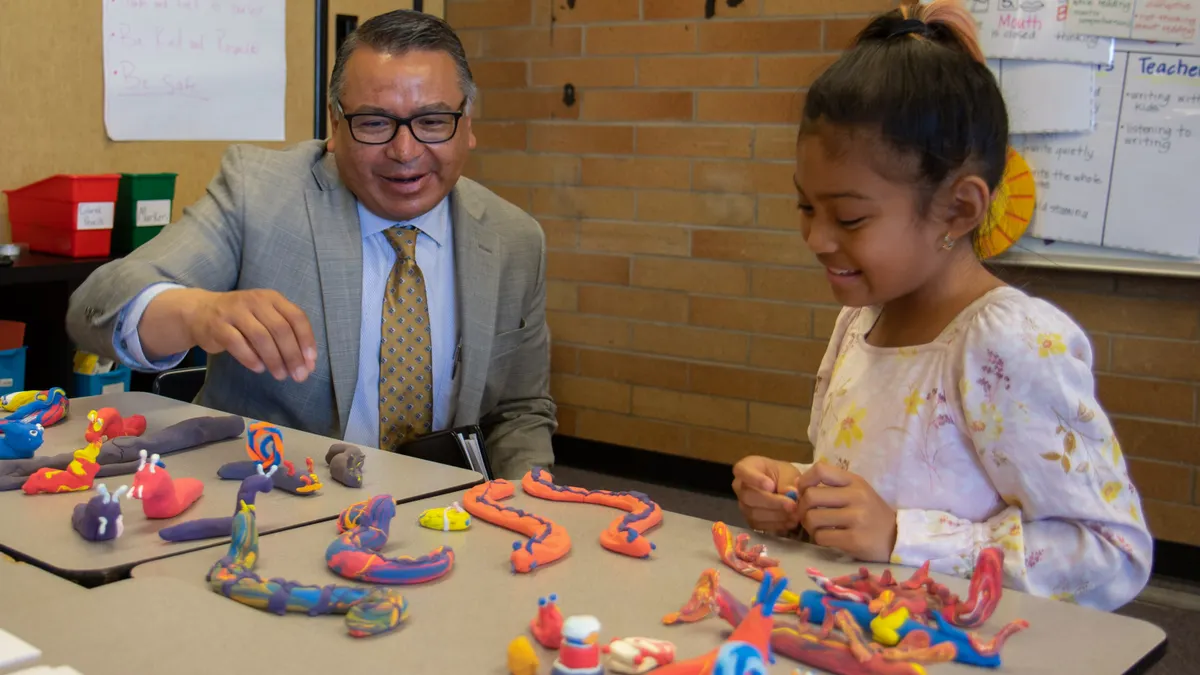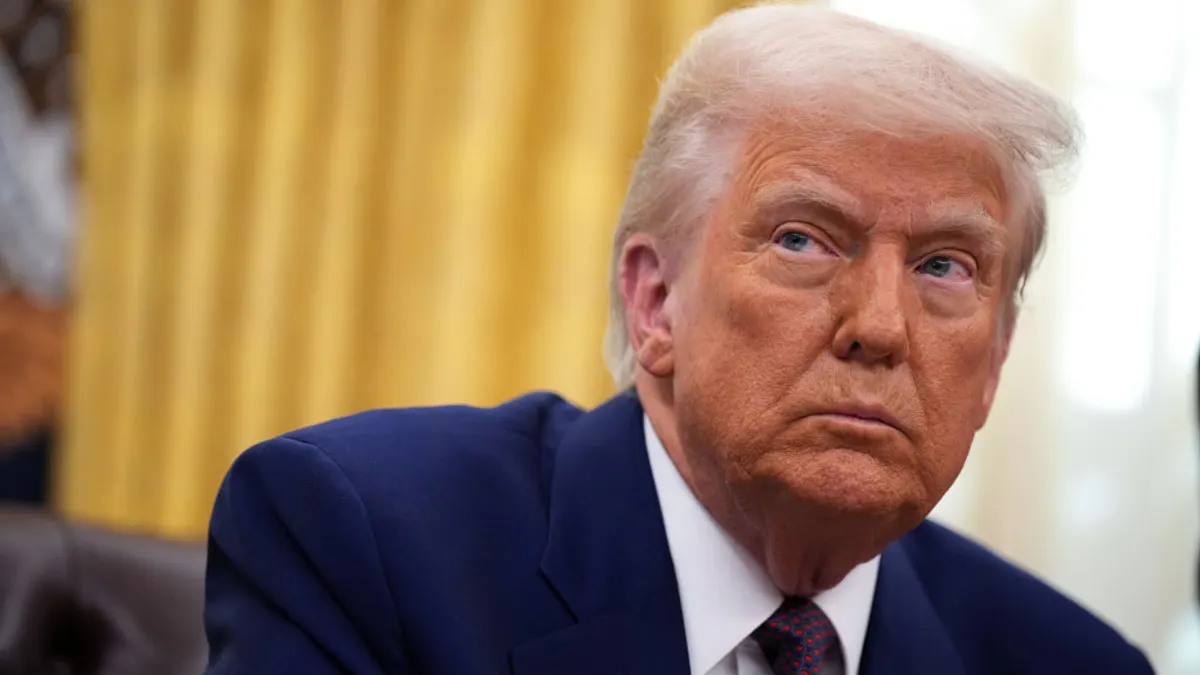In the past year, the remainder of states finalized their Every Student Succeeds Act accountability plans, the Trump administration's Federal Commission on School Safety held a number of listening sessions and issued its final recommendations, and schools continued rethinking approaches around expanding career-based educational opportunities for students as well as their own approaches to professional development.
Using that as prologue, 2019 is guaranteed to bring the next steps taken on all these fronts — from addressing the role of school climate and culture in safety to embracing new leadership models and teacher agency. Here are the six trends administrators should keep on their radar in the coming year.
Improvements in school climate and culture
A running theme across conferences Education Dive attended in 2018 was an increased level of attention on school climate and culture in efforts to boost educational equity, ranging from disciplinary practices to digital citizenship in device-driven learning environments and beyond.
Given that many states' accountability plans under the Every Student Succeeds Act include metrics of climate and culture to assess school performance — including absenteeism and suspension rates, as well as general climate surveys — it stands to reason that it's a hot topic. And it hasn't exactly not been top of mind for administrators for some time now, either.
As concerns have risen over the rash of school shootings across the nation annually, discussion of the role of climate and culture in safety frequently tries to break through the prevailing calls to harden security measures. Social-emotional learning initiatives have aimed to not just equip students with soft skills that will benefit them in their future careers, but to also develop a sense of empathy and compassion for their peers.
Coupled with improvements to school mental health offerings, this approach is eyed as a preventative measure, rather than hardened security that's designed to react when the worst-case scenario occurs and often leaves a school feeling more like a correctional facility than a warm, welcoming learning environment.
Additionally, these efforts have included steps taken away from "zero-tolerance" discipline policies in favor of restorative measures like the Positive Behavioral Interventions and Supports (PBIS) model to scale back the number of suspensions for minor behavioral infractions. Those harsher practices have tended to disproportionately impact students of color and those with disabilities, contributing to the "school-to-prison pipeline." Also key in rethinking these practices for some schools have been initiatives that train school resource officers on SEL and mentoring rather than simply serving as disciplinarians within the school building.
With the recent final report from the Trump administration's School Safety Commission ruffling some feathers with recommendations for hardened security (including armed school staff) and a scaling back of the previous administration's guidance on rethinking discipline, the actions schools and districts ultimately take, as well as their impact on climate and culture, are worth keeping an eye on.
Public investment in early childhood education
As researchers continue to seek answers about the most effective ways to support young children’s learning, leaders from the education, philanthropy and business sectors are looking to move the field beyond what states and the federal government are able to fund with public dollars.
In November, for example, foundations and entrepreneurial organizations, such as the Omidyar Network (named for eBay founder Pierre Omidyar) and the LEGO Foundation, came together with Sesame Workshop, the Campaign for Grade-Level Reading and Harvard’s Center on the Developing Child for the first Early Futures event. The new Promise Venture Studio, which supports for-profit and nonprofit startups in the early learning field, also led the two-day gathering.
“This new community will examine opportunities to build new capacity in the early learning field as it enters a critical next stage,” organizers of the event wrote in this article. Shifting demographics, with the majority of the nation’s children under five being nonwhite, and changing early experiences, such as children growing up with both parents working and living in a digital world, are among the new pressures placed on providers and school districts serving young children.
Glimpses of how the world of corporate philanthropy has taken interest in young children were seen in 2018 with Amazon founder Jeff Bezos announcing a $2 billion plan to fund full scholarships for low-income children to “Montessori-inspired” preschools. And creative models for delivering and improving services for young children are receiving support from the Saul Zaentz Early Education Initiative at Harvard University.
The question is whether public-private partnerships will develop from any of the models getting their start with support from investors and foundations — and if the next Head Start or Sesame Street is hiding among them.
Expansion of leadership models
From hiring school business managers to creating more opportunities for teacher leadership, schools will likely continue to experiment with and foster new models for leading schools — a trend that is largely driven by the growing realization that principals can’t be effective instructional leaders if they are also responsible for everything else that takes place on a school campus.
Projects, such as the Wallace Foundation’s effort to redesign principal training programs and New America’s work on how school leaders are making this shift, provide states and districts with guidance in these areas and will likely spur more state and local efforts to provide administrators with professional development focusing on instruction.
From learning how to better support teachers working with young children or how to attract and retain highly qualified teachers in STEM-subject areas, efforts to train principals to lead instruction — and evaluating them on how successful they are — will grow more targeted, depending on a school’s unique needs and challenges.
Efforts to boost teacher agency and bottom-up leadership
As noted at above, providing teachers with more opportunities to lead is part and parcel of new school leadership models. Just as federal policymakers are returning more decision-making power to states and districts under ESSA, states and districts are realizing that the people who likely have the best ideas of what works in the classroom are those on the front lines.
In November, seven principals shared with us how their roles and responsibilities are changing — with several detailing ways they had expanded the distribution of those roles to teacher leaders or created committees to give educators more voice in decisions. At the core of these efforts is a simple principle: When everyone feels that they've had an opportunity to voice their concerns and influence a decision, the buy-in will be greater at the ground floor and a new initiative is likely to roll more smoothly.
Teacher agency is important beyond just leadership, though: It's critical for innovation.
Stringent accountability measures dictated from the top down, no matter how well-intentioned, can often have the impact of stifling efforts to try new approaches. The fear of punitive measures in the event of failure can simply be too strong. However, magic often happens when the freedom to experiment is granted as exemplified by New Hampshire's competency-based ed advancements, Georgia teacher Valerie Lewis' "Ninja Warrior"-inspired "Ed Obstacles" challenge, and schools participating in the Teacher-Powered Schools Initiative.
Inspiring change through accountability
Whether it’s at a federal, state or local level, there’s an increasing emphasis on holding people or entities responsible for their results. In some cases, that’s to encourage improvement or advancement, and in others, it’s to put an end to what’s no longer working. Regardless, it already has, and will continue to, inspire change.
The nation's primary federal education policy, the ESSA, rests on holding schools accountable for their students’ performance in a more holistic sense. Every state was required to devise an accountability plan, using five selected indicators, as a way to survey which of its schools were meeting expectations and which were underperforming. All 50 states, along with Puerto Rico and the District of Columbia, had their plans approved by the end of September, and each is working to implement these new report cards. The effects are likely to be seen in the coming months.
Individuals and groups are also spotlighting issues in attempts to hold districts and others accountable for change. The educators who took part in 2018’s wave of walkouts, protests and strikes — which are starting back up in Los Angeles — did so to highlight widespread issues, including a lack of school funding and too-low salaries.
Meanwhile, in a response to a number of school shootings, students and other school community members have taken a stand, demanding that federal, state and local politicians do more to combat gun violence. And at a more localized level, select bodies — ranging from the state of Rhode Island to Boston Public Schools — have faced legal action.
Advocacy has become more prevalent in education as a means to boost accountability, and the issues mentioned above continue to develop in 2019.
Creating more professional development opportunities
Schools' primary functions are to give students a place to learn and to provide them with the tools they need to succeed. But making that happen isn't possible without the educators, administrators and other school leaders who work in each district. And as schools continue to struggle with finding and retaining high-quality teachers — schools started this fall with 100,000 classrooms that had inadequately certified or inexperienced educators — there's an increasing demand for opportunities to improve teacher engagement, morale and effectiveness.
Enter professional development.
Just as there's been a revamp of learning methods for students and a push for different types of learning models — fewer standardized tests, more personalized learning and 1:1 device programs, to name a few — officials are looking for new ways to deliver professional development to educators. A report published earlier this year found that most existing professional development doesn't meet federal criteria, further prompting a revamp of how it's done. The one-size-fits-all solution hasn't worked, and school leaders are starting to ask educators themselves what does.
Teachers are requesting more professional learning opportunities that are collaborative, personalized and relevant, as well as opportunities that can be offered in multiple formats. Similar to their students, teachers want to be able to choose whether they watch a webinar, attend an in-person workshop or try their hand at student teaching. They want options that acknowledge their strengths and help them improve their weaker areas. And they want to interact with their co-workers and have a voice in their work environment, which can make or break the decision between keeping a job and leaving.
Students need teachers who are able and enthusiastic about helping them succeed, and teachers need the same positive outlook and training opportunities to fulfill their duties. As mentioned above, improving school climate and culture is a major trend within K-12. Without adequate professional development for educators — who make up a notable portion of a school's population — creating a positive environment is less conceivable.





 Dive Awards
Dive Awards










